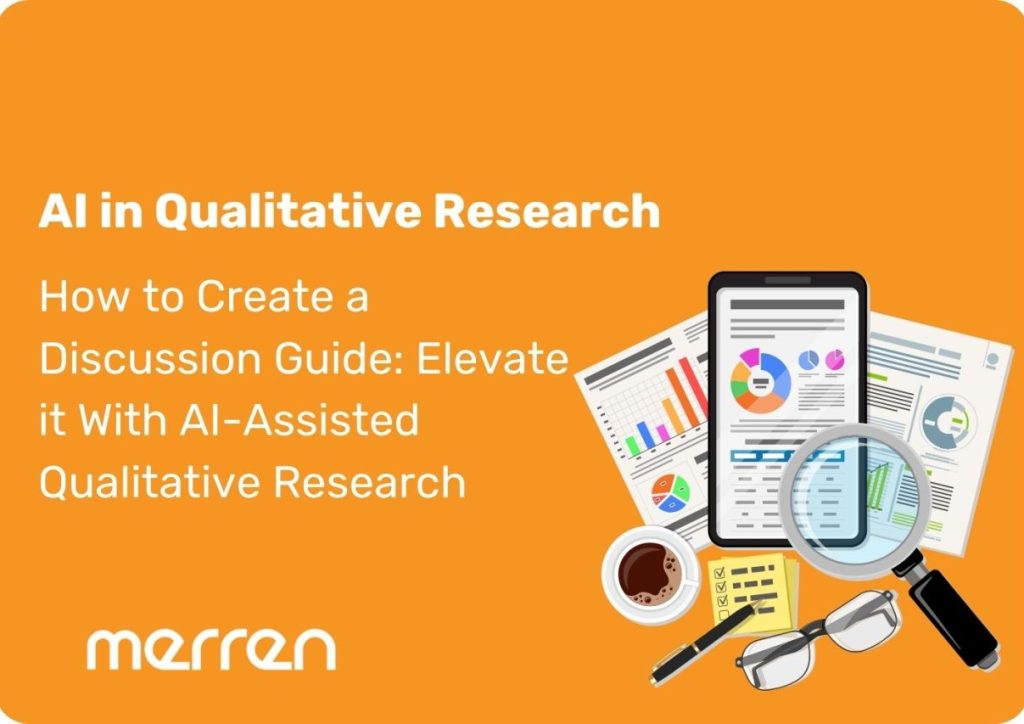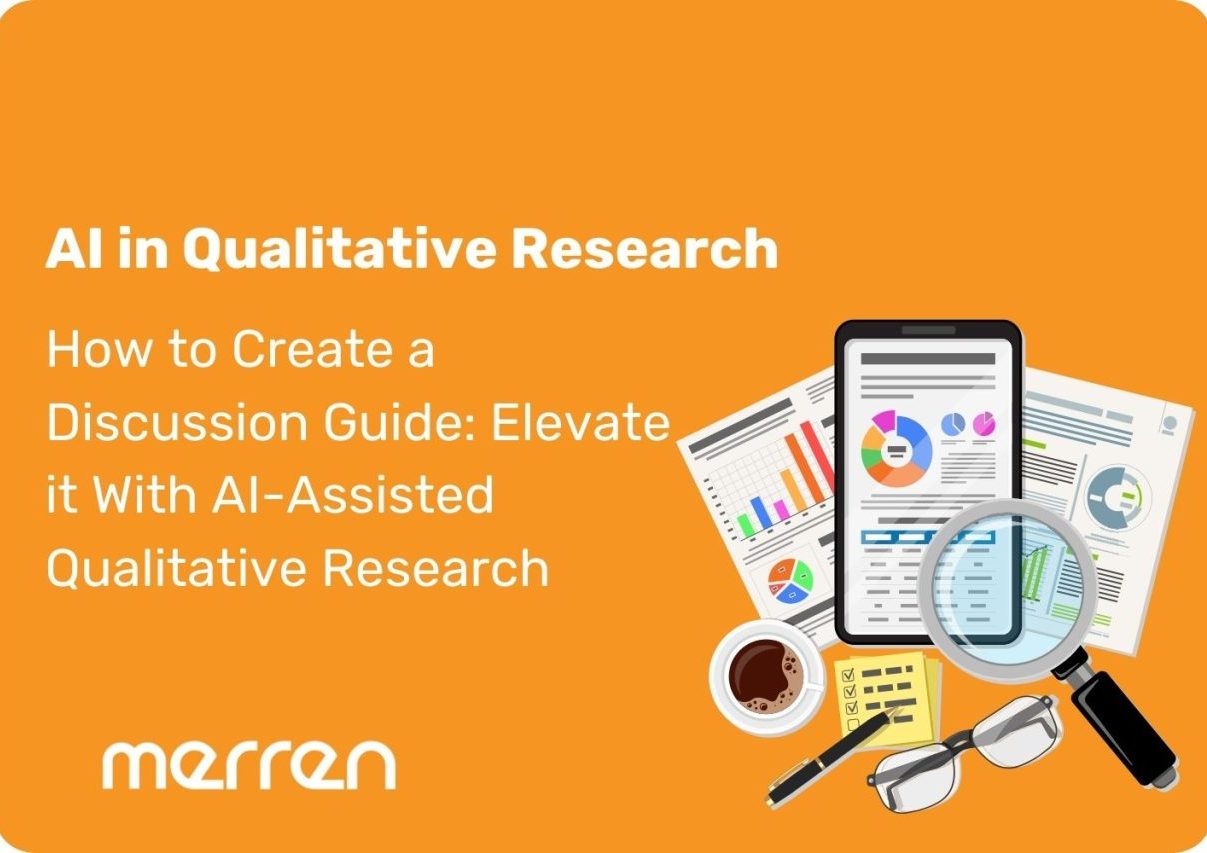A discussion guide is the Google Map of research. It enables professionals to go prepared with a question bank to conduct goal-based research. It keeps conversations on track, ensures research objectives are met, and helps uncover insights that matter. However, today there are tools that offer AI-powered discussion guides to expedite the process of market research.
What is a Discussion Guide?
A discussion guide is a structured yet flexible roadmap that keeps qualitative research focused for natural conversation to happen. It organizes the flow of questions so the moderator can cover all essential themes without sounding scripted. This includes conversations for face-to-face interviews, CATI interviews, or focused groups.
However, Merren’s AI-assisted research platform can generate discussion guides on any industry and topic in a few minutes. This saves time, manual work and gives a comprehensive guide to customise. These guides can now be instantly generated, smartly probed, and powerfully analyzed using platforms like Merren.
Core traits of Merren’s discussion guide
- Structured systematically to make respondents comfortable when they begin the survey.
- The AI probing technique can probe people on specific answers soliciting genuine explanations.
- The guides are aligned with research goals and designed to encourage storytelling and honest responses.
Why a discussion guide matters in qualitative research
Without a guide, discussions can drift, repeat, or miss critical points. Here’s why professionals rely on them:
- A flexible structure to work with: Researchers can cover key topics while having spontaneous follow-ups on a response.
- Consistent pattern recognition: Every session will cover the same themes. This will keep the data uniform for reliable insights and comparison
- Offers confidence in research method: It prepares interviewers to pace their conversations wisely. Saves time by reducing redundant or irrelevant questions.
- Aligns stakeholder on a unified agenda: The guide serves as a reference for everyone involved in the research process.
Step-by-Step: Create a Responsive Discussion Guide
Plan and create a discussion guide as per your target audience and research agenda. Here are critical non-negotiable steps to follow.
Step 1: Define research objectives
Clarify the main research goal. For example: Are you exploring customer satisfaction, product usability, or unmet needs? Your objectives shape every section of the guide. Here are some questions to ask before a framework:
- What do you want to learn?
- What decisions will this guide inform?
- Who will participate in the guide and from what industry?
The guide can have two aspects: structured questions that are mandatory. Flexible questions which will be guided by the natural course of a conversation.
Step 2: Understand your audience
Identify the persona who will participate in the survey: customers, employees, or stakeholders. Tailor your language, tone, and questions to their background and context.
Step 3: Break objectives into themes:
Turn your research goals into 3–5 key themes. Example:
- Awareness of the brand.
- Buying or usage behavior.
- Pain points or frustrations.
- Expectations for the future.
Examples of Discussion Guide Questions
Here are sample questions you can adapt for your own study:
- What first comes to mind when you think of this product?
- Can you tell me about the last time you used this service?
- What difficulties did you face during the purchase?
- If you could improve one thing about it, what would it be?
Step 4: Write open-ended questions
Craft questions that encourage conversation. Avoid yes/no questions and instead use prompts like:
“Can you describe your last experience with [product/service]?”
“What challenges do you face when using [product/service] ?”
Include optional probes like “Can you elaborate?” or “What led you to say that?”.
Mark possible detours so that if respondents bring up surprises, explore them; guides are there to support, not constrain.
Step 5: Plan the flow of the conversation
- i) Warm up: Make respondents comfortable and assure them of privacy. Greet them with warm statements and offer ice breaking questions ( light, easy-to-answer to build comfort).
- ii) Core discussion: Focus on core topics of this research. Thematic questions that dive into experiences and reasoning.
- iii) Warp up: Create closing prompts that have respondent reflection or suggestions to round off.
Step 6: Pilot and refine
Test the guide with a small group. Check if questions are clear, engaging, and aligned with your objectives. Adjust before sharing it via Merren’s AI platform.
Common Mistakes to Avoid When Writing a Discussion Guide
It can be tempting to load the guide with multiple questions to get the most out of a respondent. However, this approach will not be fruitful when scaled to a larger audience.
- Stick to the specific goal of the research without asking questions about other topics of the same industry. The respondent has formed a context of the question he/she is answering.
- Survey fatigue can build up over voice surveys too. Avoid overloading people with too many questions. This can be an issue with double baralled questions (asking two questions in a single sentence). Divide the questions into two parts.
- Don’t forget the rapport you built at the start. A person offers genuine responses when they feel welcomed.
- Follow the guide but there is no compulsion to be rigid. People are in the flow of answering the question. Focus on active listening and ask related questions.
Discussion Guide Research: How to Analyze it?
Traditionally, human researchers follow a structured but time-consuming process to make sense of qualitative data.
Transcription of the spoken word
Analysts read and re-read the transcripts to immerse themselves in the content. This stage helps them spot recurring themes, unique perspectives, and contradictions. Then they start by turning recordings or handwritten notes into transcripts. This makes it easier to review what participants actually said, word for word.
Coding and theme building
Each piece of text is categorized into labels or “codes.” For example, if participants frequently mention “checkout issues,” the researcher might code those responses under “friction in purchase journey.”
Codes are grouped into broader themes. A set of codes about “difficult navigation,” “confusing product filters,” and “slow loading times” might be combined under the theme “website usability challenges.”
Data interpretation and reporting
Human judgment comes into play here. Researchers connect themes back to research goals, industry context, and the participant’s voice to generate insights. Researchers compile their findings into reports with quotes, observations, and recommendations for stakeholders.
How to Create a Discussion Guide with Merren’s AI-Powered Platform
Here’s how you can elevate your guide using Merren’s AI-assisted tools to conduct dynamic, voice-based qualitative research:
1. AI-powered guide generation
Sign up with an enterprise plan to access all AI-powered features on Merren CX.
Your dashboard will be visible. On the top right corner, click on +create a survey.
Choose create discussion guide and click on the option.
Prompt to create an AI-powered discussion guide on Merren:
“Create a discussion guide for qualitative research. The target audience is [insert audience, e.g., first-time e-commerce customers in the USA]. The goal of my research is to [insert goal, e.g., understand customer pain points during checkout]. Focus on probing [insert product/service aspect, e.g., website usability, checkout process, and trust factors]. The guide should include: an introduction and warm-up section, participant background questions, core questions with follow-ups, and a wrap-up. Make questions open-ended, unbiased, and conversational. “
2. Voice surveys that respond instinctively
Your question set will be ready. Feel free to edit and customize questions as per research goals. Launch it with AI voice surveys via Merren.
The AI voice surveys will offer conversational survey experience where people can offer genuine responses based on these interactions. AI can immediately follow up based on what they say adapting “on the fly” like a smart moderator.
3. Transcription + sentiment & tone analysis
Every voice response is instantly transcribed into text for every question asked. It is analyzed for sentiment to understand positive, neutral, or negative tones. Merren can also detect tones like excitement or sarcasm.
4. Automated AI reports for the team
Merren will take the data and create a comprehensive report in a matter of a few hours. Merren crafts research reports with verbatim examples, sentiment breakdowns, and visuals saving you from slow batch-processing.
How AI Can Analyze Discussion Guides?
Traditionally, building a guide and analyzing responses has been a manual, time-intensive process. Now, AI platforms like Merren can streamline it by:
- Generating draft guides directly from your research goals.
- Suggesting open-ended questions tailored to your audience.
- Analyzing qualitative responses with automated coding and sentiment detection.
- Combining qualitative depth with quantitative speed.
This means you can move from objectives to insights in days/hours instead of weeks without losing richness.
Automates analysis : AI-assisted qualitative research takes over the heavy lifting of transcription, coding, and categorization.
Faster insights without losing depth : Researchers move quickly while still capturing rich qualitative detail.
End-to-end process : Platforms like Merren transcribe voice responses into text, code them, and categorize themes in real time.
Saves time : Reduces weeks of manual coding into minutes.
Keyword & tone detection : AI identifies recurring words, phrases, and emotional tones, then groups them into themes.
Sentiment analysis : Classifies responses as positive, neutral, or negative to show participant feelings.
Dynamic visualizations : Instantly generates word clouds, charts, and topic highlights.
Structured reporting : Provides reports with verbatim quotes, thematic insights, and sentiment summaries.
Human + AI collaboration : AI handles repetitive tasks like transcription and theme detection, while researchers focus on interpretation, cultural context, and strategic decisions.
Benefits of This AI-Assisted Approach
AI powered qualitative research can compile thousands of hours of manual work into a few hours of streamlined process. Here is why you should adopt the AI-assisted approach.
- Faster Research Turnaround: From weeks to hours.
- Higher Engagement: Voice and conversational formats drive better response rates.
- Deeper Insights: Emotion and tone detection adds nuance.
- Scalable & Accessible: Multilingual voice surveys via familiar channels (WhatsApp, Messenger) open reach and inclusivity.
- Better Decision-Making: Actionable reports help cross-functional teams move quickly.
Conclusion
A well-crafted discussion guide remains foundational to meaningful qualitative research. By building structure, allowing flexibility, and aligning with research goals, you create better insights.
But when you pair it with Merren’s AI-powered platform, the process transforms: guides are generated swiftly, voice surveys adapt dynamically, responses are transcribed in real time. This is the next frontier of AI-assisted qualitative research.
With Merren, you’re not just gathering what people think you’re understanding why they think it, faster and smarter.

